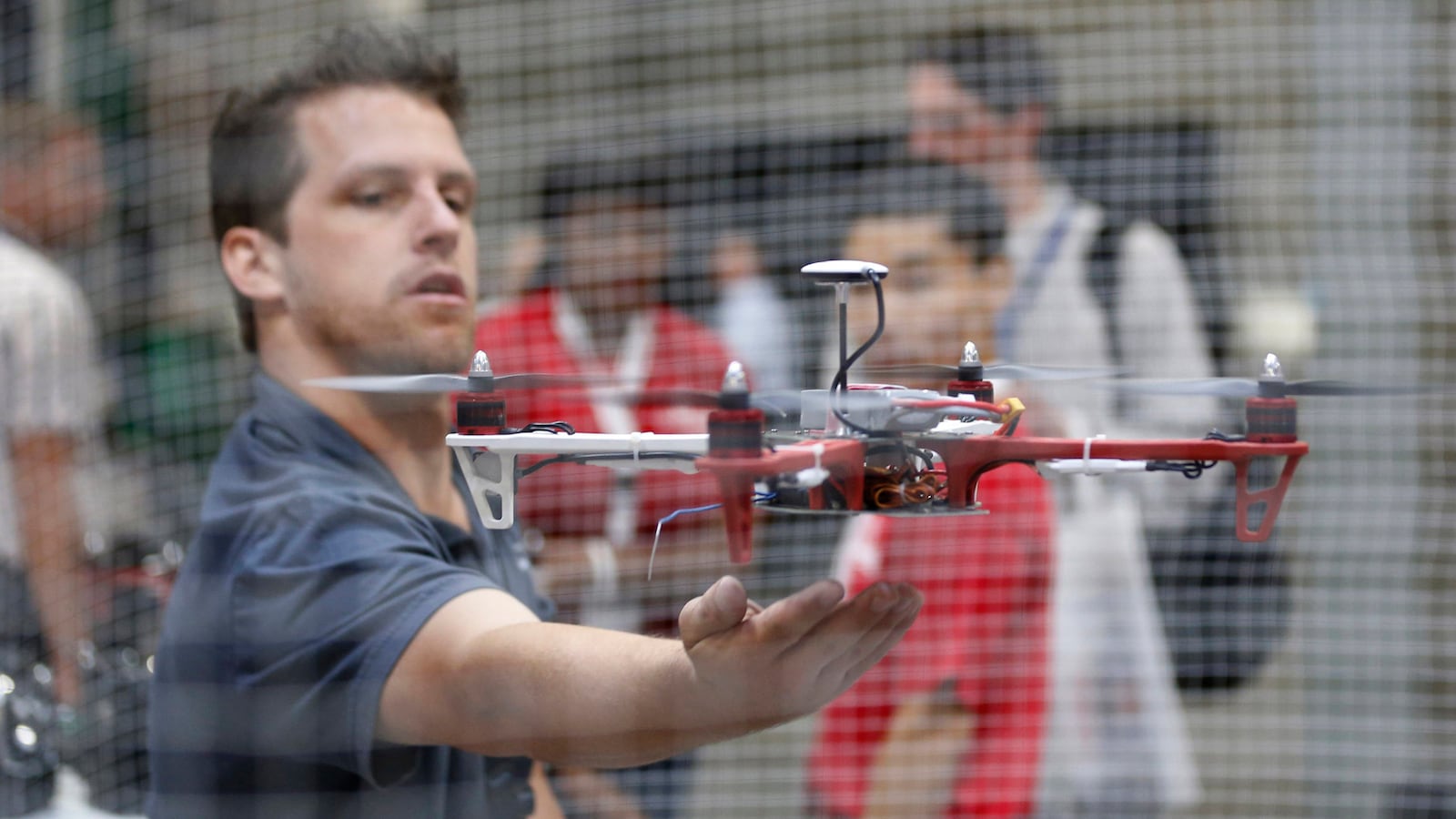Beer. Pizza. Cake. Sushi. If you can dream it, someone can drone it in.
As the debate surrounding America’s use of targeted drone killings rages on, a friendlier side of the technology is zooming to center stage. From a bakery in Shanghai to a sushi restaurant in London, companies across the globe are experimenting with unmanned aircraft to deliver—well, just about anything. Back in the U.S., however, early adopters will likely find themselves grounded in legal limbo as Congress sits on legislation regulating civilian use.

In South Africa, for example, the first known beer drone drop received ecstatic reviews two weeks ago. “Each time the drone dropped a beer into the crowd, the entire camp erupted in a fantastic roar,” says Carel Hoffman, who masterminded the event as part of Johannesburg’s Oppikoppi Music Festival. “The entire thing was supposed to be a gimmick ... just a small gimmick in the corner of the festival,” he says. But the feat was risky, and the Oppikoppi founders admit it. “We were worried that someone would stop us and say, ‘What the fuck are you doing?’” Hoffman says. No one did.
The beer drone, nicknamed “manna” after the Old Testament story in which bread falls from the sky, was built locally using borrowed parts from Hong Kong. The only thing festivalgoers had to do was download a Beer Drone app on their smartphones to request a fresh brew. If they were lucky enough to make it into “the queue,” a free beer would float through the air, parachute included, and land at their feet. Hoffman says thousands of beers were successfully flown in, turning the Oppikoppi staff into something like national heroes: “South Africa is very proud of us for the drone,” he says.
The words “proud” and “drone” sound odd in the same sentence, and Hoffman catches himself immediately. “It’s different than how they’re used in America,” he says. “I saw a headline a few days ago here that read, ‘The U.S.A. Drops Bombs on Afghanistan; We Drop Beer.’”
The origin of the food and drink delivery drone is debatable. A well-known Japanese restaurant in London, YO! Sushi, claims it deserves the credit. “YO! Sushi considers itself the first to utilize unmanned aircraft ... as a way to serve customers,” one of the company’s PR directors, James Lynch, writes in an email. YO! employs an “iTray,” essentially a drone that carries a tray of food to patrons. It was built in-house and has earned the nickname “flying waiter.” Lynch says the concept was well received, but needs work. “Customers loved the initial test phase of the iTray but we are still perfecting the technology.”
Another contender for the title of pioneer is a bakery in Shanghai called InCake. Its “treat-delivery program”—which employs three 3 1/2-foot-wide, 22-pound unmanned aircrafts to deliver cake—was suspended by Chinese authorities on July 25. Speaking to a Shanghai news station, the bakery’s general manager, Wang Pingshi, explained that he was going to “improve the safety factors” of the drones in order to get the civil aviation authority’s approval.
In America, the fun has yet to completely begin. Until Congress passes the FAA Modernization and Reform Act of 2012—which includes a section on integrating civil drones into national airspace—the only way to legally get down with drone delivery is by using one small enough to be classified as a “toy drone.” The FAA also prohibits the use of unmanned aircraft when they are used for profit (and has reportedly sent letters to individuals who are doing so demanding they stop), but there is no legislation on the books to make the offense punishable by law.
Sen. Dianne Feinstein, who chairs the Senate Select Committee on Intelligence, admitted recently that the issue has Congress stumped for the time being. “This question has to be addressed, and we need rules of operation on the border, by police, by commercial use, and also by military and intelligence use,” Feinstein told Hardball’s Chris Matthews in March. “So this is now a work in progress. We are taking a look at it on the intelligence committee, trying to draft some legislation. The administration is looking at a rules playbook as to how these won’t be used and how they will be used. So it’s a very complicated subject of new technology, and I think we have to take a pause and get it right.”
Until any legislation goes into effect (the FAA act would take effect in September 2015 at the earliest), the lines remain blurry. A viral clip of two brothers, Alex and Harry Vartanian, using a drone to deliver dry cleaning from their Philadelphia store—and, presumably, collecting a profit in the process—is proof. Reached on the phone at Manayunk Cleaners, Alex excitedly confirmed that it was indeed he and his brother in the video, but said there were no consequences with the law. To the contrary, the Vartanians have been inundated with phone calls asking for more demonstrations. Asked where he procured the machine, Alex chuckled. “We bought it online.”
You can too.
Sites like DroneFly.com, founded by friends Taylor Chien and Frank Tesoro, constitute a growing online market. Since their site opened in March, the two say they’ve sold an enormous amount (“thousands”) of the DJI Phantom—the drone used by the Vartanians to deliver clothes. Their customers vary from SWAT team members to Realtors, filmmakers to disaster relief workers. “Basically everyone’s dream is to be able fly, right?” Tesoro says. “This is the next best thing.”
Purchasing a drone online is as easy as buying socks. Personal drones vary, both in price and capability. Simple ones, like Apple’s Parrot AR.Drone 2.0, run as low as $299 and include a built-in HD video recorder. In the big leagues, however, the drones basically fly themselves. More sophisticated models like the $679 Phantom DJI come complete with advanced autopilot, a GoPro HD camera, and a built-in GPS—with an easy-to-use clicker to navigate it. Long story short: if you can operate a remote-control car, you can operate a drone.
Admittedly, discussing the use of drones in the context of pleasure can be a bit unsettling. Chien and Tesoro are aware of the implications of selling unmanned aircraft, but believe that strapping an exposive to your own civil drone—at this point at least—is nearly impossible; the toy drones can hold no more than 2 pounds. On a more honorable note, the two explain how disaster-relief workers and SWAT team members are using the technology for good. “What gets me excited is the idea of flying this over a disaster-relief area ... without putting anyone in danger,” Tesoro says. “All these things make drones valuable.”
So when will these gift-bearing, potentially life-saving drones turn from American dream into a legal reality? If all goes well in Congress, civil unmanned aircraft could be taking the sky by storm as early as September 15, 2015.
Think fast, delivery boys. Your days may be numbered.






